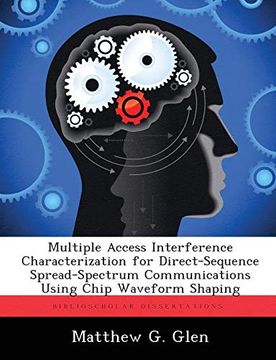Share
Multiple Access Interference Characterization for Direct-Sequence Spread-Spectrum Communications Using Chip Waveform Shaping
Matthew G Glen (Author)
·
Biblioscholar
· Paperback
Multiple Access Interference Characterization for Direct-Sequence Spread-Spectrum Communications Using Chip Waveform Shaping - Matthew G Glen
Choose the list to add your product or create one New List
✓ Product added successfully to the Wishlist.
Go to My Wishlists
Origin: U.S.A.
(Import costs included in the price)
It will be shipped from our warehouse between
Thursday, July 11 and
Thursday, July 18.
You will receive it anywhere in United Kingdom between 1 and 3 business days after shipment.
Synopsis "Multiple Access Interference Characterization for Direct-Sequence Spread-Spectrum Communications Using Chip Waveform Shaping"
The modern world has an increasing demand for wireless multiple access communications; direct-sequence spread-spectrum multiple access (DS/SSMA) systems comprise many of these communication systems. A better understanding of multiple access interference (MAI) effects on DS/SSMA system performance, specifically their impact on overall system bit error rate (BER), enables system designers to minimize MAI degradation and produce greater DS/SSMA system capacity. This research characterizes MAI effects on DS/SSMA system performance through simulation in Matlab?, and explores the impact of multiple access code selection, chip waveform shaping, and multiple access code length on BER for both synchronous and asynchronous multiple access networks. In addition, the simulated DS/SSMA model permits rapid research into the effects of additional factors on BER. Prior to experimental testing, model validation is conducted through single user trials and by comparison with existing research for similar system designs. For synchronous and asynchronous networks, Gold coding improves BER by 7.5 and 4.0 dB, respectively, relative to aperiodic random spreading codes. Synchronous network results show that chip waveform shaping provides no significant BER improvement for the Blackman or Lanczos shapes. However, asynchronous network results show a potential BER improvement for Blackman and Lanczos shapes. Increasing code length from 31 to 511 resulted in a 7.5 dB BER improvement. Collectively, these results directly relate changes in BER to waveform cross-correlation statistics.
- 0% (0)
- 0% (0)
- 0% (0)
- 0% (0)
- 0% (0)
All books in our catalog are Original.
The book is written in English.
The binding of this edition is Paperback.
✓ Producto agregado correctamente al carro, Ir a Pagar.

